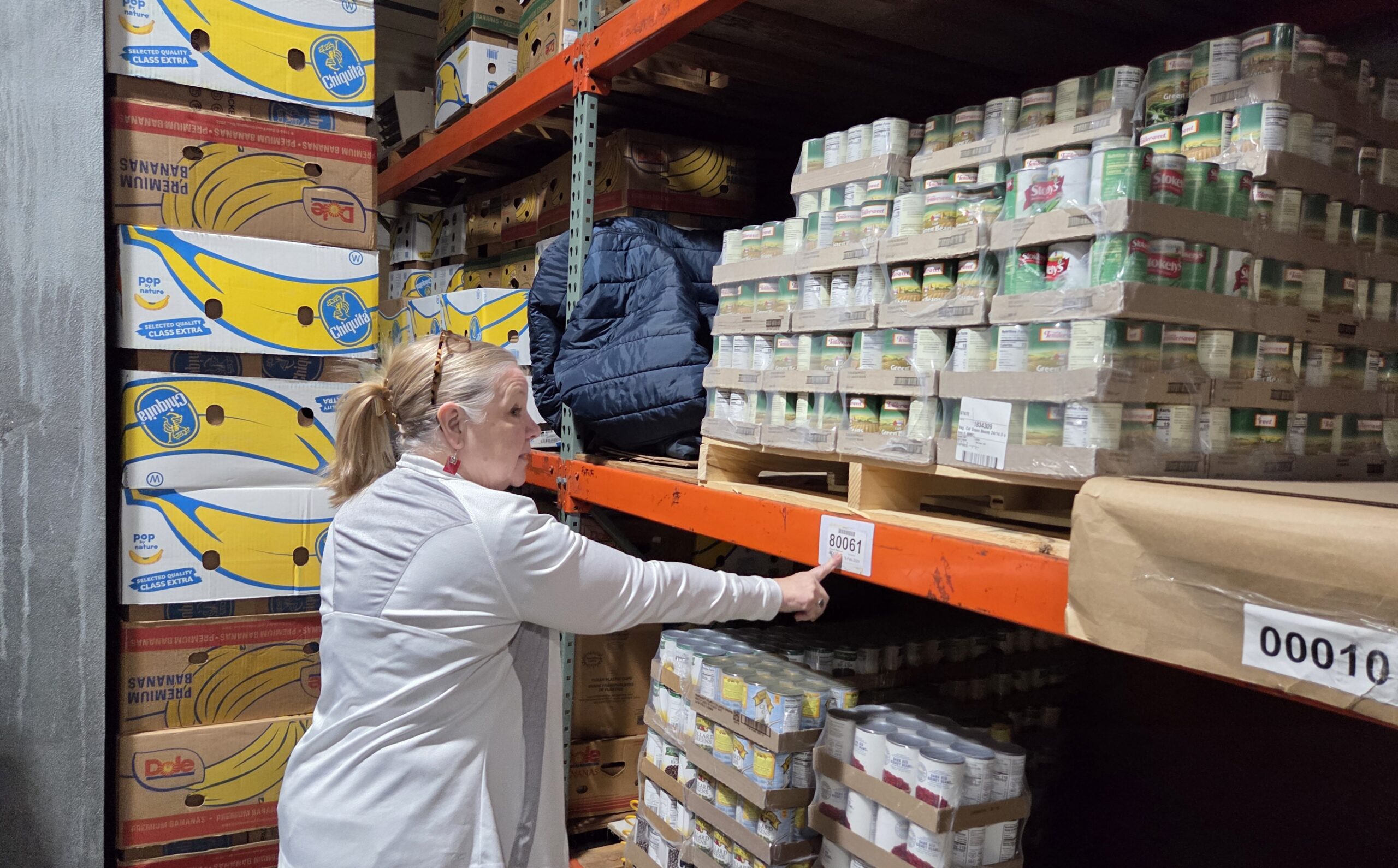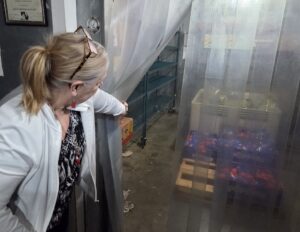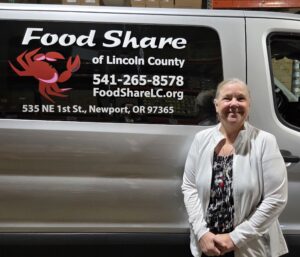
By SHAYLA ESCUDERO/Lincoln Chronicle
Eighteen pantries across Lincoln County that distribute food to people in need may see 40 percent less food from the U.S. Department of Agriculture after the Trump Administration cancelled several food deliveries to the Oregon Food Bank.
Lincoln County’s regional food bank is bracing for the impact and planning to make sure 2,000 families that rely on its services still get food on their tables.
As part of an ogoing effort to slash the federal budget, the U.S. Department of Agriculture under the Trump administration pulled the plug on $500 million in aid through the Emergency Food Assistance Program. The action cancelled food deliveries across the country, including an estimated $6 million in shipments and an additional $1 million in support distribution earmarked for Oregon.
Between 35 percent and 40 percent of the food that Food Share of Lincoln County distributes to 18 pantries comes from USDA through its emergency food assistance program. Much of the food that comes from that program is fresh produce, meats, dairies and cheeses.
“Not only are we losing food, we’re losing that fresh, healthy food,” said Nancy Mitchell, executive director of Food Share of Lincoln County.

Mitchell walks through the Food Share of Lincoln County warehouse running her finger along the shelves that hold hundreds of cans and packages — beans, masa, green beans and milk stacked from floor to ceiling. Inside a commercial refrigerator are crates of clementine oranges and pears stored before making their way to the 18 pantries across Lincoln County.
Along each shelf of goods there is a barcode and a five-digit number, Mitchell says as she points to a placard. The inventory that comes from the USDA starts with the number eight. As she moves back and forth between the rows of cans, she takes a tally.
“If you look at this wall there’s eight, eight, eight, eight, eight, eight,” she said, “Just that wall right there that’s 50-60 percent from the USDA.”
Mitchell received notice of the cuts via an email March 18 from the Oregon Food Bank and immediately took notice of all the cancelled food. There won’t be any fresh dairy coming from the Fresh Fluid USDA program for May, June and July. Two truckloads of cheese and 13 truckloads of fresh meat won’t be making it to Oregon food banks either.
The Oregon Food Bank receives about 45 truckloads of food a month from the federal Emergency Food Assistance Program. From April through July, the agency will be receiving 30 truckloads, losing a third of its deliveries.
That means less food making its way to regional food banks, including Lincoln County.
Who relies on food banks?
About 2,000 families a month rely on the food bank’s services, and that number is only growing.
About 15 percent of Lincoln County’s 50,000 residents live in poverty, compared to the 11 percent national average, according to the U.S. Census.
The county also ranks in the bottom third – 25th out of 36 counties – for medium household income, averaging $57,795 compared with a statewide average of $76,632, according to The Ford Family Foundation’s most recent “Oregon by the Numbers” report. The county also ranks in the upper third for child poverty and uncertainty of access to adequate food, according to the study.
“We’ve seen about a 19 percent increase in families using food programs in Lincoln County from the last year or two,” Mitchell said.

Food Share has several distribution sites across the county as well as programs for low income seniors to receive food boxes. There are also pantries in low-incoming housing in Newport and Lincoln City.
According to the organization’s website, food is distributed across 18 pantry sites, including Newport Food Pantry, and Waldport Food Share, but not the Yachats Food Pantry which gets all of its supplies from donors. There are four hot meal sites and 31 food boxes delivered monthly to seniors.
“We’re gonna have less food and still more people to feed,” she said, “The gap is wide, definitely.”
There are certain challenges that come with being located in Lincoln County. Being both rural and on the coast means less access to farms and commercial distributors that may be able to close that gap, she said.
There is a hope that the decision to cancel the food deliveries may be overturned, but if it isn’t and the Oregon Food Bank distributes less food, the organization may have to dip into its reserves to help fill those holes, Mitchell said. It’s not something the organization has historically done because they have been able to rely on the USDA food, she said.
But even that can only be sustainable so long. Maybe six months, maybe until the end of the year.
Still, she’s optimistic.
”When the recession hit … our shelves really were bare, and we put out word to the community, saying ‘We’re struggling here’ and help just came, ” she said, “People didn’t want to see their neighbors go hungry.”
With so many expenses that people are facing from rising food prices to housing, Mitchell understands that people may not be able to give now, but if they are able to she says that a dollar goes farther than a can of food, especially when factoring in the limited warehouse space available.
“I’ve been here 25 years, I’ve seen the ebbs and flows, I think it’s safe to say that we’re always going to have something to offer people accessing services,” Mitchell said.
Uncertainty ahead
Every Wednesday an Oregon Food Bank truck makes a delivery from Portland to Food Share’s warehouse in Newport.
Last week it brought 18,000 pounds of food – 13,000 pounds coming from the USDA. The amount was larger than usual — a portion from the previous week’s shipment as well. The truck usually delivers between 10,000 to 12,000 pounds of food a week that eventually make their way to various sites across the county.
So far, the items are regular, a mix of shelf foods and fresh produce. But workers are wary they may soon see the contents change, and the trucks a little lighter.
“We look pretty good right now, but we’re still in March,” Mitchell said, “There is just so much uncertainty, that I think we’re all just kind of waiting to see how we need to respond, but everybody’s planning, some sort of response.”
- Shayla Escudero covers Lincoln County government, education, Newport, housing and social services for Lincoln Chronicle and can be reached at Shayla@LincolnChronicle.org





















This report is chilling. Thank you for letting us know.
The pain inflicted by the Trump Administration is being felt here in Lincoln County. That means local tax dollars will have to be used to replace federal funds. Be prepared for reduced services. And, of course, it’s the poorest of the poor who will be hurt the most.
https://foodsharelc.org/new-donate-to-food-share-now/
Can I make a donation by check?
Yes! Please mail your personal or business check to: Food Share of Lincoln County, 535 NE 1st Street, Newport, Oregon 97365 or drop it by our warehouse at the same address during business hours.
Yachats Food Pantry does not receive food from the government. We rely on donations from the community and others and buy food from Grocery Outlet in Newport. Our generous donors keep food on the shelves for our clients.
Pamela Luderitz/Yachats Food Pantry